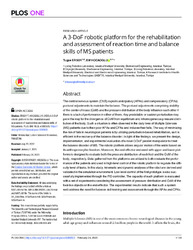A 3-DoF robotic platform for the rehabilitation and assessment of reaction time and balance skills of MS patients
| dc.contributor.author | Ersoy, Tuğçe | |
| dc.contributor.author | Hocaoğlu, E. | |
| dc.date.accessioned | 2023-09-19T07:07:41Z | |
| dc.date.available | 2023-09-19T07:07:41Z | |
| dc.date.issued | 2023-02-24 | |
| dc.identifier.issn | 1932-6203 | en_US |
| dc.identifier.uri | http://hdl.handle.net/10679/8867 | |
| dc.identifier.uri | https://journals.plos.org/plosone/article?id=10.1371/journal.pone.0280505 | |
| dc.description.abstract | The central nervous system (CNS) exploits anticipatory (APAs) and compensatory (CPAs) postural adjustments to maintain the balance. The postural adjustments comprising stability of the center of mass (CoM) and the pressure distribution of the body influence each other if there is a lack of performance in either of them. Any predictable or sudden perturbation may pave the way for the divergence of CoM from equilibrium and inhomogeneous pressure distribution of the body. Such a situation is often observed in the daily lives of Multiple Sclerosis (MS) patients due to their poor APAs and CPAs and induces their falls. The way of minimizing the risk of falls in neurological patients is by utilizing perturbation-based rehabilitation, as it is efficient in the recovery of the balance disorder. In light of the findings, we present the design, implementation, and experimental evaluation of a novel 3 DoF parallel manipulator to treat the balance disorder of MS. The robotic platform allows angular motion of the ankle based on its anthropomorphic freedom. Moreover, the end-effector endowed with upper and lower platforms is designed to evaluate both the pressure distribution of each foot and the CoM of the body, respectively. Data gathered from the platforms are utilized to both evaluate the performance of the patients and used in high-level control of the robotic platform to regulate the difficulty level of tasks. In this study, kinematic and dynamic analyses of the robot are derived and validated in the simulation environment. Low-level control of the first prototype is also successfully implemented through the PID controller. The capacity of each platform is evaluated with a set of experiments considering the assessment of pressure distribution and CoM of the foot-like objects on the end-effector. The experimental results indicate that such a system well-address the need for balance skill training and assessment through the APAs and CPAs. | en_US |
| dc.language.iso | eng | en_US |
| dc.publisher | Public Library of Science | en_US |
| dc.relation.ispartof | PLoS ONE | |
| dc.rights | Attribution 4.0 International | * |
| dc.rights | openAccess | |
| dc.rights.uri | http://creativecommons.org/licenses/by/4.0/ | * |
| dc.title | A 3-DoF robotic platform for the rehabilitation and assessment of reaction time and balance skills of MS patients | en_US |
| dc.type | Article | en_US |
| dc.description.version | Publisher version | en_US |
| dc.peerreviewed | yes | en_US |
| dc.publicationstatus | Published | en_US |
| dc.contributor.department | Özyeğin University | |
| dc.identifier.volume | 18 | en_US |
| dc.identifier.issue | 2 | en_US |
| dc.identifier.wos | WOS:000972006100049 | |
| dc.identifier.doi | 10.1371/journal.pone.0280505 | en_US |
| dc.identifier.scopus | SCOPUS:2-s2.0-85148885565 | |
| dc.contributor.ozugradstudent | Ersoy, Tuğçe | |
| dc.relation.publicationcategory | Article - International Refereed Journal - Institutional Graduate Student |
Files in this item
This item appears in the following Collection(s)
Share this page




